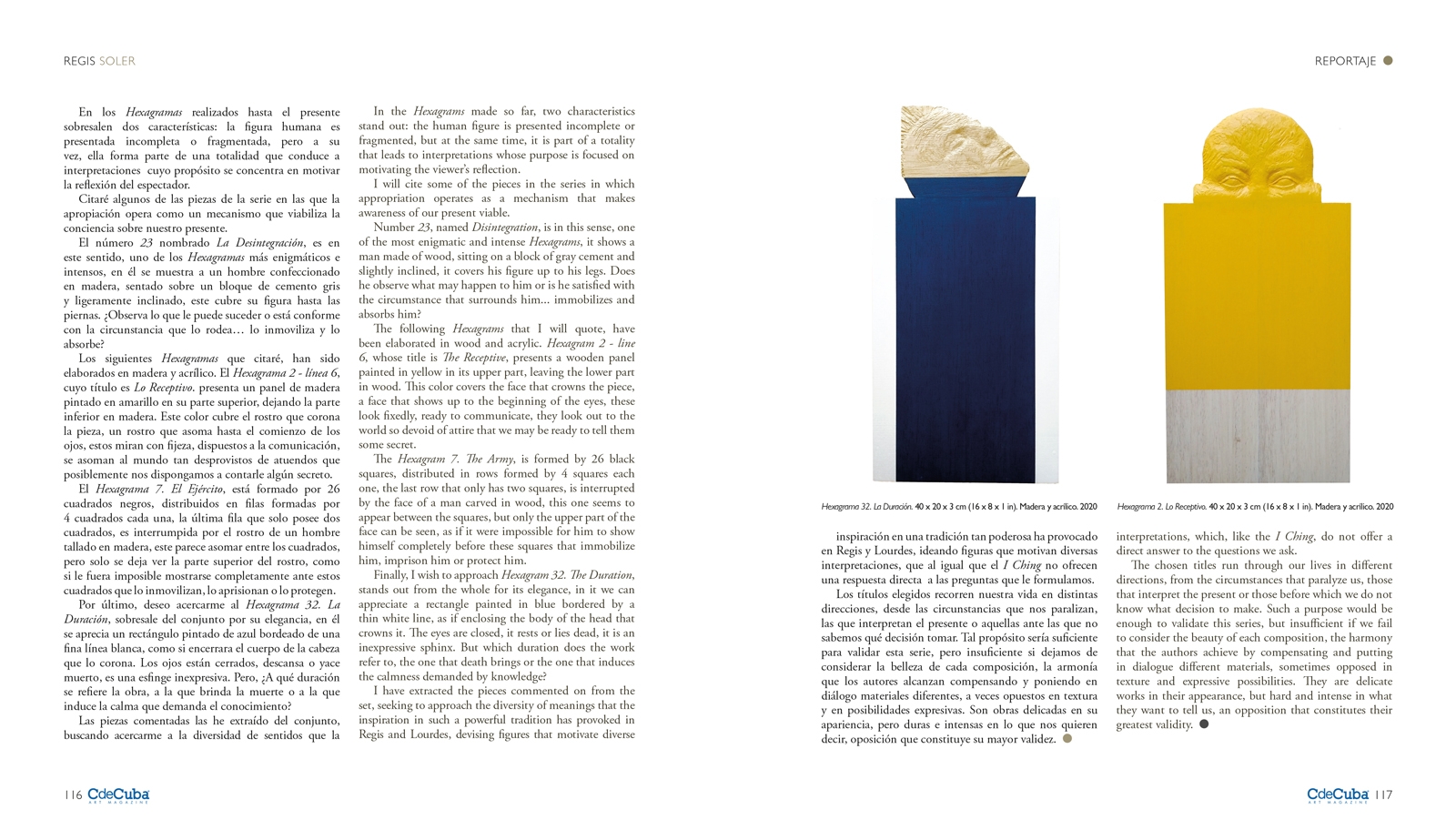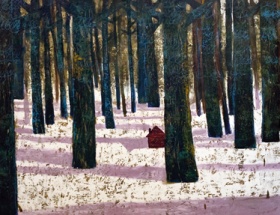Regis Soler Models his Sensitivity
By Magaly Espinosa
The sculptor is an angel of form, he creates them by transforming reality, involving himself in each transformation as if the modeled objects were part of his own body. His gestures, his physical strength, his breathing, enter into them, charging them with his energy.
Regis Soler has developed an extensive career as a sculptor that dates back to the 1980s, remaining to this day among the creators of this type of art that has experimented the most with the appropriative procedure and with the assembly of diverse materials that, when fused, bring us closer to the poetry and spirituality of a transfigured reality.
Through exhibitions such as Convivencia (1990), La fortaleza traslúcida (1995), Fragmentos deseados (1999), Perspectiva del alma (2005), El momento observado (2020), the latter with the participation of his wife, architect and designer Lourdes Chong Rodríguez, Regis shaped a poetics in which his own experience played a primordial role, as he points out: “My subjective world full of prejudices, frustrations, disappointments, convictions, virtues and defects marked by the imprint left by the social environment”.
But at the same time, the expressive force, the plastic beauty, the power of synthesis given through the fusion of contents taken from different religious and cultural origins, of diverse formal values, together with the sense of humor incorporated to them, are aesthetic particularities pointed out by several scholars who have written about his work, elements that typify the sculptural production of this artist in the Cuban artistic context.
Appropriating pagan and Catholic tradition, Spanish imagery and Renaissance aesthetics, is one of the ways adopted to activate a procedure that is not limited to the combination of forms, but to the expressive possibilities they provide, creating new visions supported, in turn, by titles that load the pieces with content and take them beyond their historical and aesthetic references, placing them in dialogue with the present.
In this direction we could comment on the work S/T (1989) of small format, made of wood, plaster and acrylic paint. It shows us the image of a naked man carrying a cross on his back; but on this occasion the religious symbol has been replaced by one of everyday life, a clothespin, inviting us to a joke that tries to refer to a routine domestic work that can be as heavy as the real cross.
Simiente (2018) is another of his works that allows us to evaluate the particularities of his aesthetics, which, as we said, combines humor and appropriation. Small format, in wood and acrylic, it shows us a naked couple painted in white from the legs to the shoulders, while the faces maintain the natural texture of the wood, approaching a type of medieval figuration. The artist has taken up the biblical characters of Adam and Eve, the woman adopts a flirtatious pose, while he seems to want to approach her, the legs of both are hidden in an abstract painting done in white and blue.
Their most recent exhibition project, El momento observado (The Observed Moment), is made up of 17 pieces, which, like those previously mentioned, maintain the style of small format sculptures. Lourdes and Regis have approached the ancestral wisdom of the I Ching, the Chinese oracular book, with the purpose of “…unraveling through three-dimensional images a world hidden from the senses”. They explain that “…to elaborate the pieces they were based on the interpretation of the hexagrams that compose the book, making several images and selecting materials and formal solutions in accordance with the expression of the signs, in such a way that their exegesis has as main purpose to activate the senses of the spectator.
In the Hexagrams made so far, two characteristics stand out: the human figure is presented incomplete or fragmented, but at the same time, it is part of a totality that leads to interpretations whose purpose is focused on motivating the viewer’s reflection.
I will cite some of the pieces in the series in which appropriation operates as a mechanism that makes awareness of our present viable.
Number 23, named Disintegration, is in this sense, one of the most enigmatic and intense Hexagrams, it shows a man made of wood, sitting on a block of gray cement and slightly inclined, it covers his figure up to his legs. Does he observe what may happen to him or is he satisfied with the circumstance that surrounds him… immobilizes and absorbs him?
The following Hexagrams that I will quote, have been elaborated in wood and acrylic. Hexagram 2 – line 6, whose title is The Receptive, presents a wooden panel painted in yellow in its upper part, leaving the lower part in wood. This color covers the face that crowns the piece, a face that shows up to the beginning of the eyes, these look fixedly, ready to communicate, they look out to the world so devoid of attire that we may be ready to tell them some secret.
The Hexagram 7. The Army, is formed by 26 black squares, distributed in rows formed by 4 squares each one, the last row that only has two squares, is interrupted by the face of a man carved in wood, this one seems to appear between the squares, but only the upper part of the face can be seen, as if it were impossible for him to show himself completely before these squares that immobilize him, imprison him or protect him.
Finally, I wish to approach Hexagram 32. The Duration, stands out from the whole for its elegance, in it we can appreciate a rectangle painted in blue bordered by a thin white line, as if enclosing the body of the head that crowns it. The eyes are closed, it rests or lies dead, it is an inexpressive sphinx. But which duration does the work refer to, the one that death brings or the one that induces the calmness demanded by knowledge?
I have extracted the pieces commented on from the set, seeking to approach the diversity of meanings that the inspiration in such a powerful tradition has provoked in Regis and Lourdes, devising figures that motivate diverse interpretations, which, like the I Ching, do not offer a direct answer to the questions we ask.
The chosen titles run through our lives in different directions, from the circumstances that paralyze us, those that interpret the present or those before which we do not know what decision to make. Such a purpose would be enough to validate this series, but insufficient if we fail to consider the beauty of each composition, the harmony that the authors achieve by compensating and putting in dialogue different materials, sometimes opposed in texture and expressive possibilities. They are delicate works in their appearance, but hard and intense in what they want to tell us, an opposition that constitutes their greatest validity.






